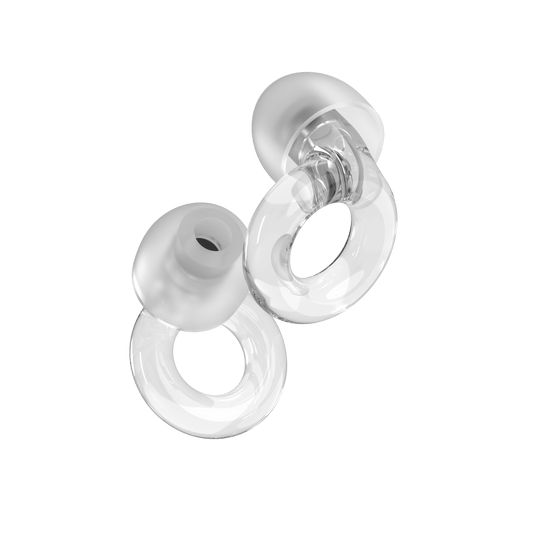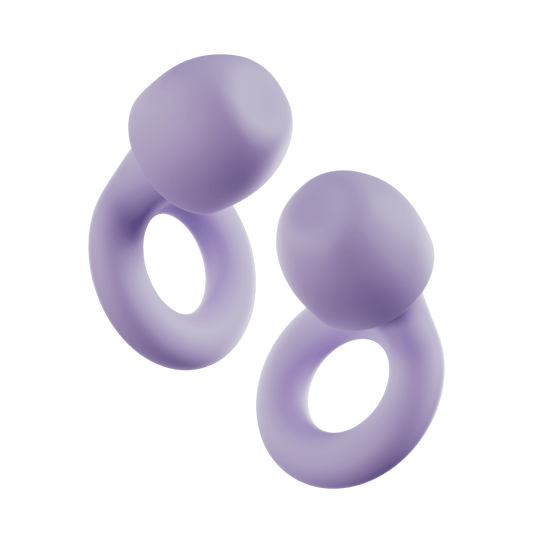Key takeaways
- There are three main types of tinnitus: subjective, somatic and objective
- Subjective tinnitus is the most common form of tinnitus, causing a ringing or buzzing in the ears that can only be heard by the person with the condition
- Somatic tinnitus is a sub-type of subjective tinnitus that’s related to movement which triggers tinnitus
- Objective tinnitus is a rare type, which can be heard by other people when in close proximity or using a stethoscope
- There are also three possible tinnitus sounds: tonal tinnitus, pulsatile tinnitus, and musical tinnitus
- Tinnitus can either be bilateral (affecting both ears) or unilateral (affecting just one ear)
Tinnitus is a fairly common condition, causing a ringing or buzzing in the ears. But did you know that there are different types of tinnitus? That means that everyone who has tinnitus has a different experience, and may have different symptoms. If you have the condition, it’ll fall into one of the tinnitus types outlined below.

Subjective tinnitus
When someone has subjective tinnitus, it causes a ringing or buzzing in their ears that can only be heard by them. It’s the most common form of tinnitus, accounting for 95% of all cases, and it can come on suddenly and can either be a temporary or permanent condition.
Causes of subjective tinnitus
Subjective tinnitus is often caused by exposure to loud noise and noise-induced hearing loss. It can also be caused by a variety of other conditions, including:
- Ear infections
- Impacted ear wax
- Meniere’s disease
- Ototoxic drugs
- Head injuries or trauma
- Metabolic disorders like thyroid conditions, vitamin B12 deficiency and diabetes
Treatment for subjective tinnitus
This type of tinnitus can’t be cured in most cases, so the best way to avoid it is through prevention. This is especially important given how common tinnitus is with frequent and prolonged exposure to loud noises.
A study into the prevalence of tinnitus found that 19.2% of adults who were exposed to loud noises at work had tinnitus and 17.1% of adults who were exposed to loud noise during their leisure time also had the condition.
Hearing damage is possible after 8 hours of exposure to sounds at 75 decibels, roughly equivalent to a street full of traffic or a noisy restaurant. Wearing earplugs for tinnitus can help, whether you’re proactively protecting yourself from developing tinnitus, or you already have the condition and want to avoid making it any worse.
Somatic tinnitus
Somatic tinnitus is actually a type of subjective tinnitus. It’s sometimes called somatosensory tinnitus.
It’s usually related to head, neck or dental issues, but can also be related to movements of the eyes or limbs. When someone with this type of tinnitus moves their head, neck, jaw or another body part in a certain way, it can trigger tinnitus. It can also be caused by dental issues, like impacted wisdom teeth or a jaw that pops.
For some people, it doesn’t take much to trigger their somatic tinnitus. Something as simple as turning their head to face the other way on the pillow can trigger that annoying buzzing in their ears. Or maybe it’s turning their neck to check their car’s blind spot as they’re pulling out of a parking space. The resulting muscle spasm and tinnitus doesn’t necessarily come straight after the movement, and it can happen hours later.
In some cases, people with somatic tinnitus can even adjust the loudness or pitch of their tinnitus by manipulations of his or her jaw, eye movement, or by applying pressure to the head or neck.
Causes of somatic tinnitus
It’s thought that somatic tinnitus is caused by damage to the dorsal cochlear nucleus (DCN). This is the first part of the brain that auditory signals travel through on their way to the auditory cortex, where the majority of processing happens.
Auditory signals are sent to the DCN via hair cells in the cochlea, as well as from muscle position sensors. When either the DCN or the inputs that send data to the DCN are damaged, it can affect how sounds are perceived. There’s some confusion between auditory and sensory signals, meaning that sensory input can cause tinnitus, or make existing tinnitus worse.
There are a variety of things that can cause this type of tinnitus, including:
- Exposure to loud noises, resulting in hearing damage
- Head injuries
- Temporomandibular Joint (TMJ) dysfunction
- Grinding teeth
- Orthodontic treatment that stresses the maxillary and mandibular systems
- Dental surgery that puts pressure on the jaw
- Sitting with bad posture for too long
- Muscle inflammation
Treatments for somatic tinnitus
Because this type of tinnitus is often quite clearly linked to a specific movement, or has occurred as a result of a specific medical condition or injury, treatment is usually linked to the cause.
That could mean it’s as simple as treating muscle inflammation or getting treatment for tooth grinding. On the other hand, if the tinnitus stems from botched dental work or TMJ dysfunction, it could take more work to fix the root issue.
The first step is to get your tinnitus diagnosed by a doctor. They’ll be able to assess whether you have any other issues, and advise an appropriate course of treatment. If you have issues with your TMJ, for example, treatment may include dental surgery or orthodontic work to realign your jaw and improve your dental bite, or wearing a mouthguard at night.
Other types of treatment can also be effective for this type of tinnitus, including tinnitus retraining therapy and sound therapy. It may not be possible to cure somatic tinnitus completely, but it is usually possible to reduce the symptoms.
Objective tinnitus
Objective tinnitus is the only form of tinnitus that’s audible to someone other than the person with tinnitus. It can usually be heard by someone else using a stethoscope, but in extreme cases it can also be heard simply by being in close proximity to the ear.
It’s the rarest tinnitus type – but it’s also the only type that can be completely cured. Subjective tinnitus is a neurological condition, caused by the perception of sound when there is no external noise present.
With objective tinnitus, there is still no noise present, but it’s usually caused by a vascular disorder or another condition. When the condition is treated, the tinnitus is also treated, and it may go away permanently.
Causes of objective tinnitus
Objective tinnitus is usually caused by conditions that produce sound either within the ear or near the ear. That can include things like:
- Aortic stenosis (a type of heart valve disease)
- Mitral regurgitation (a condition which causes the backward flow of blood to the heart)
- Arteriovenous malformations, when a group of blood vessels form incorrectly
- Fatty deposits sticking to artery walls
- High jugular bulb
- Vascular tumors
- Acoustic neuroma, a type of non-cancerous brain tumor
- Anemia
- Middle ear inflammation
- Muscle contractions
- Paget’s disease
Objective tinnitus treatments
This type of tinnitus can be treated by treating the condition that is leading someone to hear sounds in their ear. This may result in an improvement in their tinnitus, or it could clear it up completely.
Types of tinnitus sounds
As well as considering the different kinds of tinnitus, it’s also important to recognise that different people can experience different tones or sounds with their tinnitus.
There are three main tinnitus sounds that people can experience: tonal, pulsatile and musical tinnitus.
Tonal tinnitus
This is when someone experiences whistling, ringing or humming sounds, which have well-defined frequencies.
This is the most common type of tinnitus and is likely what you think of when you think about tinnitus: a buzzing, ringing or whooshing sound in the ears.
Pulsatile tinnitus
This is tinnitus that’s experienced as a rhythmic pulsing which is often in time with a person’s heartbeat. When one’s heart rate increases, the tinnitus sound will also get faster, and when the heart rate decreases, the sound usually also gets quieter.
People can often hear their own heartbeats after a workout, but people with pulsatile tinnitus can often hear it even when they haven’t exerted themselves. It may be noticeable when lying in bed at night or in other quiet environments, as there is nothing to mask the sound.
Pulsatile tinnitus is almost always objective tinnitus, although it can sometimes be subjective. That means it can often be treated successfully, once the source of the tinnitus has been established.
A variety of different conditions can cause this tinnitus sound, including:
- High blood pressure
- Anemia
- Blood vessel disorders
- Atherosclerosis (a narrowing of the arteries)
Musical tinnitus
Musical tinnitus is very rare. It sounds like music or singing in someone’s ears, when no music is being played. It usually doesn’t mirror any music the person has heard recently, and is different from an ear worm in which a song gets stuck in your head.
When someone has musical tinnitus, they’ll often mistake the music they’re hearing for real music, until it becomes clear that there is no music being played and it’s in their head only.
There is usually no underlying cause of musical tinnitus, although it can occasionally be caused by serious conditions like brain tumors or problems with blood vessels. It is also more common in people with epilepsy or Alzheimer’s – so it’s important to see your doctor if you experience symptoms of this type of tinnitus. It can also be caused by hearing loss.

Bilateral vs unilateral tinnitus
It’s also worth pointing out that people can either have bilateral tinnitus (when they have tinnitus in both ears) or unilateral (when they have tinnitus in one ear only).
More people experience bilateral tinnitus, and the most common causes of bilateral tinnitus are hearing damage and hearing loss.
If someone has tinnitus only in one ear, it’s more likely to have an underlying medical issue that needs to be addressed. It may be caused by something simple like impacted ear wax, but it could also be a red flag of a more serious underlying medical condition such as:
- Hearing loss
- Acoustic neuroma, a non-cancerous tumor that grows on the auditory nerve and can cause hearing loss, tinnitus and dizziness
- Trauma to one year, such as close proximity to a gunshot
- Ménière’s Disease, which can cause tinnitus to move from ear to ear
If you have permanent or intermittent tinnitus in one ear, it’s likely it’s not a sign of something more serious – but it could be, so it’s always important to get it checked out by a medical professional.
Our earplugs
Living with tinnitus
Whatever type of tinnitus you have, it can be difficult to live with. Luckily, there are ways to reduce your symptoms and, depending on what kind of tinnitus you have, you may even be able to overcome it completely.
Although it might seem like it sometimes, remember that you’re not alone if you have tinnitus. Seek support from friends and family, speak to your doctor to find the best treatments for your specific case, and join online support groups to find like minded people who really get what it’s like to live with tinnitus.

What is Tinnitus?
What is Tinnitus? Tinnitus is an audiological and neurological condition. It’s the perception of sound when no actual...

Unveiling the Top 5 Causes of Tinnitus
Discover the top 5 causes of tinnitus and gain insights into why your ears ring. Expert advice for identifying trigge...

How to prevent tinnitus and protect your ears
Prevention is the best cure, right? And when it comes to tinnitus, properly protecting your ears can go a long way to...


















